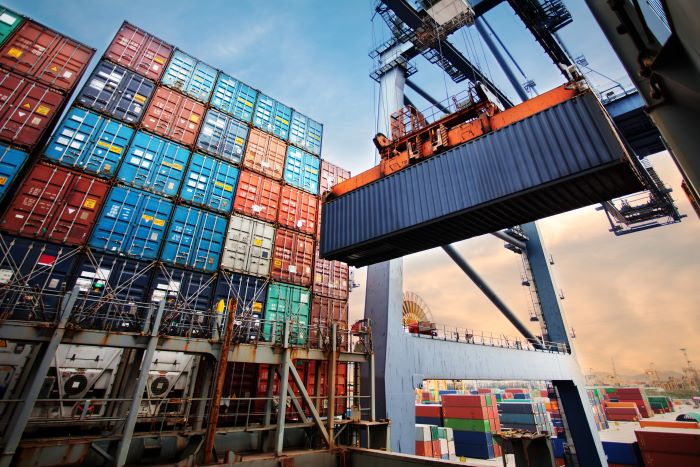Larry Gross, president and founder, Gross Transportation Consulting, and JOC analyst

Adjustments made by carriers amid the US import surge are creating much bigger problems further down the supply chain, manifesting in reduced productivity and imbalances on key inland components. Photo credit: Shutterstock.com.
Now that the Suez Canal has been unblocked, attention is shifting back into the much longer-running — and perhaps more significant — issue of port congestion, particularly in Southern California. A record import surge has been pointed to as the main culprit.
But how much of the current problem is really due to higher volumes? A closer look indicates that a substantial portion is due to declining port productivity. Simply put, once a port gets behind the eight ball, it is extremely hard to get back on track.
To put the current situation in better context, we’ll review data for the last six months (September through February) with the same period one year ago and two years prior. Data on individual ports are based on the monthly laden volume reports produced by the ports themselves. The North American stats include data from PIERS, a sister company of JOC.com within IHS Markit.
For North America (the US and Western Canada), current volume has consistently been running above the prior years throughout the last six months. For the period from September through February, total import TEUs were up 17.2 percent versus the prior year. But compared to two years ago, the gain was 11.6 percent. Still strong, but meaningfully lower. Year-ago volume went below two years prior in October and stayed there for the balance of the six-month period.
The interesting thing about the current trend is that import TEUs reported since October have generally been declining. With a substantial backlog of ships waiting to be unloaded, why should volume be going down? One would hope (or expect) that volume would remain steady, or even increase, as the facilities ramped up to meet demand. The decline from month to month indicates that the productivity of the ports is declining steadily.
Hard to play catch-up
Looking at individual ports, while Los Angeles has had a very sizable increase of almost 24 percent versus one year ago, when compared to two years ago, it is only 6.4 percent. Should that have been enough to bring the port’s operations to its knees? At the peak in October 2020, Los Angeles handled 507,000 imported TEU. This was 4.3 percent more than was handled in October 2018, a difference of 21,000 TEU. This equates to perhaps two additional ship calls. Also notable is that the increase from prior month was much greater in 2018 than it was in 2020.
To be fair, the port was operating at a handicap in 2020. Crews were running short-handed because of the pandemic and the port’s capacity was effectively reduced. What the numbers show is that once a port gets behind, it becomes exponentially harder to catch up. Now, even as fully or partially vaccinated workers are helping to return crews to full strength, productivity is still dropping owing to lack of space, lack of chassis, lack of railcars, etc. Velocity, once lost, is hard to regain.
Imports in Long Beach peaked in December, and February import TEUs were 8 percent below the peak. This compares with an 18.5 percent decline from the peak in import TEUs handled in February for Los Angeles.
Unlike the Los Angeles and Long Beach port complex, the two biggest East Coast ports, New York/New Jersey and Savannah, have not yet had the comparison artificially boosted by weak prior year results. Their considerable gains are roughly the same versus last year and two years ago. This, therefore, was true growth.
These ports have seen declines over time as well. New York has steadily moved down since October, with February some 17 percent lower than the peak in October. Savannah was able to keep things together all the way through January, although volume plunged in February, resulting in an 18 percent drop from the peak.
Vancouver’s story is much like Los Angeles and Long Beach’s. This includes an easy comparison with the prior year, a much smaller growth number versus two years prior, and generally declining import volume handled per month from the peak in October.
What can we draw from these figures? The first is that the current surge, while significant, is not quite as strong as the year-over-year figures indicate. The second is that a good chunk of the current tightness is not simply elevated market demand, but rather strong demand colliding with sinking productivity as congestion mounts.
The third and perhaps most intractable conclusion is that the newfound power of ocean carriers to flex their operations up and down to meet market conditions has improved their profitability, but has also entailed heavy costs elsewhere in the supply chain. Those on the receiving end of these changes in the form of blanked voyages followed by “pedal to the metal” operations with random extra loaders thrown in are being whipsawed.
The adjustments on the part of the carriers are creating much bigger problems as one travels further down the supply chain. This is currently manifesting in reduced productivity and imbalances on key inland components including ports, chassis, and rail transport. Now these woes are completing the circle to bite ocean carriers in the form of equipment imbalances impairing their ability to meet the demand in overseas export markets.
Eventually the current problems will get sorted out. Likely it will take some moderating of demand, which may not be around the corner. But clearly better coordination and signaling between key components of the international supply chain are needed to keep this from happening next time.